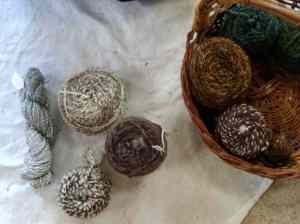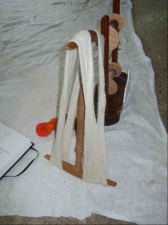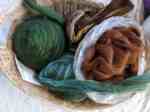I’ve been having a quiet week in North Wales with my wife and daughter. No music, no weaving, just a lot of rain and wind, and a cottage full of books to read. Susan and I have found ourselves engrossed by the first two of Steig Larsson’s extraordinary Millennium series and I have notched up a Daphne Du Murier (My Cousin Rachel), Arundhati Roy’s The God of Small Things (my second go at this strange book) and currently really enjoying E.H.Gombrich’s The Story of Art – a book I should have read years ago. Escaping the clouds hanging over the mountain most of the time, we’ve visited a number of car boot sales and restocked the cottage library.
As we left Sarn village, after a particularly successful charity bookstall raid, I noticed a sign advertising ‘spinning and weaving’. In a collection of huts and workshops we found a small gallery, a pottery and various craft spaces. Making enquiries I discovered that I could arrange a one-to-one introduction to spinning from Lynne, a member of the local guild of spinners, weavers and dyers. So later in the week, clutching notebook and camera, I turned up for a three-hour session. It was exactly what I had been looking for, what I had surmised as an important gap in my knowledge and experience of textile craft.
My guide to this very special craft was a lady who loved all aspects of working with wool. She was clearly well practised in putting the elements of Spinning across to beginners with enthusiasm. Lynne Shepherd is the co-ordinator of the Lynn Guild of Weavers Spinners and Dyers, a very active guild who meet weekly at Pen y Groes. She’s only recently started teaching at Sarn, so I felt myself most fortunate to have the opportunity of this introduction within a few miles of where I stay in this beautiful part of the Lynn peninsula.
Lynne had taken real care to set up a varied collection of yarns, wools, wheels, accessories, books and all kinds of examples. This collection of resources made her guide to spinning encompass many things I had simply not expected. She was able to tell the whole story of working with wool from the fleece to the garment. She began with wool itself, the fleece to be exact. She had a bag full of Welsh Mountain fleeces and a series of staples that included Romney, Wensleydale, Shetland, Llyn and Welsh Mountain. She stressed how important it was to take great care over hygiene in handling a fleece and demonstrated how a fleece might be combed and cleaned. I was allowed the choice of working from a raw fleece or ready prepared hanks of wool. For combing, in addition to a drum carder, she recommended a dog comb.
The next step was to explain the difference between spinning and plying and the intricacies of wpi (wraps per inch). We looked at what went to make 2 or 4 ply yarns. I was introduced to a basket of ready-prepared yarns that included Torwen, Herdwick, Merino, Alpaca and Welsh Mountain. At last I felt able to hold these natural yarns in my hand and ask all the questions I’d ever wanted to ask. Lynne was keen to recommend Wingham Wool Work as a great source for such wools, and explained how this Yorkshire-based company regularly make visits to guilds across Wales so that members can try before buying wools.
As if to cue, while this examination was going on, a visiting artist preparing a local exhibition appeared to buy a spindle – a kind of portable spinning wheel. I even got a demonstration.
It was then a very small step to examine dyeing, natural dyes in particular. We looked at examples of Kidd Mohair and Alpaca. I discovered the importance and nature of natural mordants, the catalysts of the dyeing process, how to dye in the microwave, how to dye in a glass jar with a piece of copper pipe (!), and how the local Lynn Guild regularly hold dyeing days when members can experiment with having ‘several dye pots on the go’. Books recommended included A Dyer’s Garden by Rita Buchanan (Interleave Press) and mention of the Dye Garden at Trefrew.
Now it was time to explain and use the wheel itself. Lynne had brought three wheels with her: one, locally made, with an attached bobbin holder (2 full – 1 on the wheel to enable the plying process to take place), and two traditional Ashford wheels. But first the Niddy-Noddy! I had never seen this strange hand-held device before. It’s a bit like a warping frame for spinners. I was taught how to wind a spun yarn onto it to enable me to make a hank, from which I was then shown the umbrella action skeiner and wool winder. I’d seen both before, and often wondered what they did!
Finally, in this ‘working backwards approach to Spinning’ I got to sit at the wheel to learn the treadling action. Quite tricky. It took me some time to be able to control the wheel motion properly with my foot.
My first attempt at spinning itself from the wool was with a piece of Alpaca dyed green. I found the co-ordination very difficult and it took the best part of forty minutes to be able to feel something of the correct motion. I also managed to master joining a strand of wool on to the spun thread. The spinning action is certainly something one has to practise over and over again – and I did make a useful video from my camera of Lynne’s ‘action’. I did feel, however, that I had captured something of the basics. If I can borrow my mother-in-law’s wheel then maybe next time I come to Lynn (possibly in the early autumn, it may be worth Lynne’s while to give me some further tuition. I do feel that this is one craft that certainly has to be learnt by example (Lynne did recommend one book – The Essentials of HandSpinning by Mabel Ross, published by Wingham Wool Work 1999). I remain most grateful to this thoughtful spinner for such a thorough and interesting introduction, whether I can take the craft forward or not.
A footnote – during my spinning session a mother and daughter spent an hour or so weaving on very simple cardboard box looms! I’d never seen these box looms before and in comparison to my rather awkward frame looms they were great for beginnings (and competent weavers too!). I append some examples to the gallery images. Essentially, these are standard banana boxes strengthened at the top of the box by two pieces of wood taped at either end of the box. Brilliantly simple!
- A Banana Box Loom
- Woven on a Banana Box Loom
- The Mother of Alll
- Skeiner and Wool Winder
- A Niddy-Noddy
- Colourful Alpaca
- A collection of pre-prepared wool
- A collection of dyed wools
- A collection of wools
- Staples
- Lynne Shepherd at the wheel














August 25, 2009 at 7:05 pm |
Oh my goodness. If you are not careful you are not only going to be owning sheep but breeding them so you can get precisely the kind of wool you want…
I love, love, love spinning, something I once swore I’d never do as I didn’t see the point of it. It is the most therapeutic craft I pursue. And yes, you are right, it will take time and practice. I’d practice for a bit, maybe a week, maybe a month, and then go get some more tuition. When I was in the practice stage and taking classes, after each class I would try to spin for once a day for no more than an hour each time. For me, that seemed to be the most productive for learning.
Having sung in choirs all my life, I am now taking voice lessons! The teacher had been highly recommended and I had experienced group lessons with her for a week at our choir music camp. She knew exactly where to begin with me and has set the goals exactly I would have had I had the vocabulary/understanding to describe them. So like you and weaving and spinning, I am excited beyond speech about singing.